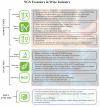From Vineyard Soil to Wine Fermentation: Microbiome Approximations to Explain the " terroir" Concept
- PMID: 28533770
- PMCID: PMC5420814
- DOI: 10.3389/fmicb.2017.00821
From Vineyard Soil to Wine Fermentation: Microbiome Approximations to Explain the " terroir" Concept
Erratum in
-
Corrigendum: From Vineyard Soil to Wine Fermentation: Microbiome Approximations to Explain the "terroir" Concept.Front Microbiol. 2017 Jun 12;8:1065. doi: 10.3389/fmicb.2017.01065. eCollection 2017. Front Microbiol. 2017. PMID: 28616012 Free PMC article.
Abstract
Wine originally emerged as a serendipitous mix of chemistry and biology, where microorganisms played a decisive role. From these ancient fermentations to the current monitored industrial processes, winegrowers and winemakers have been continuously changing their practices according to scientific knowledge and advances. A new enology direction is emerging and aiming to blend the complexity of spontaneous fermentations with industrial safety of monitored fermentations. In this context, wines with distinctive autochthonous peculiarities have a great acceptance among consumers, causing important economic returns. The concept of terroir, far from being a rural term, conceals a wide range of analytical parameters that are the basis of the knowledge-based enology trend. In this sense, the biological aspect of soils has been underestimated for years, when actually it contains a great microbial diversity. This soil-associated microbiota has been described as determinant, not only for the chemistry and nutritional properties of soils, but also for health, yield, and quality of the grapevine. Additionally, recent works describe the soil microbiome as the reservoir of the grapevine associated microbiota, and as a contributor to the final sensory properties of wines. To understand the crucial roles of microorganisms on the entire wine making process, we must understand their ecological niches, population dynamics, and relationships between 'microbiome- vine health' and 'microbiome-wine metabolome.' These are critical steps for designing precision enology practices. For that purpose, current metagenomic techniques are expanding from laboratories, to the food industry. This review focuses on the current knowledge about vine and wine microbiomes, with emphasis on their biological roles and the technical basis of next-generation sequencing pipelines. An overview of molecular and informatics tools is included and new directions are proposed, highlighting the importance of -omics technologies in wine research and industry.
Keywords: 16S rRNA gene sequencing; NGS; bioinformatic tools and databases; metagenomic analysis; soil microbiome; vine health; wine microbiome.
Figures
References
-
- Andorrà I., Landi S., Mas A., Esteve-Zarzoso B., Guillamón J. M. (2010). Effect of fermentation temperature on microbial population evolution using culture-independent and dependent techniques. Food Res. Int. 43 773–779. 10.1016/j.foodres.2009.11.014 - DOI
-
- Apprill A., McNally S., Parsons R., Weber L. (2015). Minor revision to V4 region SSU rRNA 806R gene primer greatly increases detection of SAR11 bacterioplankton. Aquat. Microb. Ecol. 75 129–137. 10.3354/ame01753 - DOI
Publication types
LinkOut - more resources
Full Text Sources
Other Literature Sources


